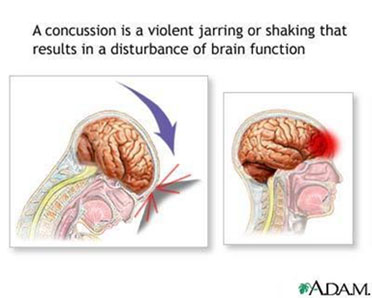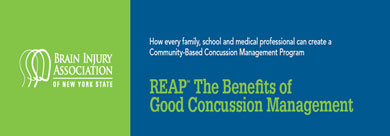Sports Concussion
Concussion 101

A concussion...
is a traumatic brain injury (TBI)
is caused by a bump or rapid movement of the head
is a temporary loss of brain function
When the brain is hit, it has the potential to move inside the skull This can lead to bruising, and damage to nerves and blood vessels; causing a concussion
Generally, the longer the individual is unconscious, the more severe the injury but keep in mind, loss of consciousness is not necessary for a concussion to occur.
Concussions: True/False
1. A concussion is just a “bump on the head”.
False!
Actually, a concussion is a traumatic brain injury (TBI). The symptoms following a concussion can range from mild to severe and usually involve: confusion, disorientation, memory loss, slowed reaction times and extreme emotional reactions. The severity of the symptoms cannot be predicted at the time of the injury.
2. A parent should awaken a child who falls asleep after a head injury.
False!
Current medical advice is that it is not dangerous to allow a child to sleep after a head injury, once they have been medically evaluated. The best treatment for a concussion is sleep and rest. (Parents are encouraged to wake their child every 3-4 hours to check mental status during the first 24 hours after concussion.)
3. A Concussion is usually diagnosed by neuroimaging tests (CT scan, MRI, etc.).
False!
Concussions cannot be detected by neuroimaging tests; a concussion is a “functional” not structural injury. Concussions are typically diagnosed by careful examination of the signs/symptoms of concussion at the time of injury. The cause of symptoms during a concussion are thought to be due to an ENERGY CRISIS in the brain cells. At the time of a concussion, the brain cells (neurons) stop working normally. The “fuel” (sugar) that is needed to generate activity – for playing and for thinking- is simply not being delivered efficiently to the cells. As a result, a symptom will “flare.” It is the brain’s way of telling the body that it is not working properly. While a CT scan or an MRI is often used to rule out more serious bleeding in the brain, it is not a diagnostic test for concussion. A negative scan does not mean that a concussion did not occur.
4. Loss of consciousness is necessary for a concussion to take place.
False!
According to the American Academy of Neurology (AAN), a concussion is any “traumatically induced alteration in mental status that may or may not involve a loss of consciousness.” CDC reports that an estimated 1.6 to 3.8 million sports- and recreation-related concussions occur in the United States each year.3 Ninety percent of concussions do not involve a loss of consciousness. While many students receive a concussion from sports-related activities, numerous other concussions occur from non-sports related activities — from falls, from motor vehicle, bicycle and playground accidents.
REAP the Benefits of Good Concussion Management
Reduce
Educate
Accommodate
Pace |
 |
A new community-based concussion management program is now available free-of-charge. The REAP (Reduce, Educate, Accommodate, Pace) project was initially developed in Colorado after the loss of a student from "second-impact syndrome." REAP is a model program that empowers schools, families, students, and medical professionals to come together to help young people achieve the safest recovery from concussion. We encourage everyone to utilize this invaluable tool and pass it on!
The REAP project works on the premise that concussion is best managed by a Multi-Disciplinary Team that includes: the Student/Athlete, the Family, various members of the School Team and the Medical Team. You will see color-coded suggestions for each “team member” throughout the manual making it easy to follow. You will also find a symptom checklist for use at home or on the field, sections dedicated to explaining the most common problems seen after concussion and a ‘note to teacher’ template to be given to the students’ teacher after concussion has been assessed. The REAP project takes the guesswork out of caring for your child or student after brain injury. Start using it today!
HEADS Up: Concussion in Youth & High School Sports
Heads Up is a program by the Centers for Disease Control. The CDC has created free tools for youth and high school sports coaches, parents, athletes, and health care professionals that provide important information on preventing, recognizing, and responding to a concussion.
Order your materials here
Heads Up to Clinicians: Addressing Concussion in Sports among Kids and Teens
Heads Up to Schools: Know Your Concussion ABC’s
Heads Up: Concussion in Youth Sports
Heads Up: Concussion in High School Sports
Heads Up: Brain Injury in Your Practice
Return to Learn & Return to Play
Return to Learning: Going Back to School Following a Concussion
Return to Learn: Supporting Students Returning to the Classroom Post-Concussion
BIANYS Webinar Series (Feb 2012) Brian Rieger, PhD.
A “Heads Up” on Managing Return to Play: Information for health care professionals
Concussion Management and Awareness Act 3953b
Read Full Text
Chapter 496 of the Laws of New York 2011
(excerpt taken from the REAP Project)
Requires:
- Immediate removal from athletic activities of a student believed to have sustained or who has sustained a mild brain injury
- No return until student is symptom free for at least 24 hours; must be evaluated and receive written permission to return by a licensed physician
- All coaches, physical education teachers, nurses and athletic trainers are required, biennially, to complete a course of instruction relating to recognition of symptoms of mild brain injury and monitoring and seeking appropriate medical treatment
- Parents or others in parental relationship must sign permission slip that contains information relating to concussion
- NYS State Education Department, NYS Department of Health and school districts must post information on their websites
Discretionary:
- School districts are authorized to establish a concussion management team to oversee the implementation of concussion policies and procedures in the district and to be a resource for parents, athletes, and school staff
Implementation:
- NYS State Education Department, in conjunction with NYS Department of Health to promulgate necessary regulations for implementation
- Effective date: July 1, 2012
For more information about the course of action you need to take, visit the NYSED’s website and your local school districts' website.
Webinars
Brain Injury in Youth: Promoting Effective Concussion Management and Recovery
-In this webinar, Dr. Jay Dunkle will provide information about concussion-related issues, services, and programs that can have positive results on strengthening cognitive skills and emotional regulation for youth who have sustained a concussion.
-Dr. Dunkle is a trained Clinical Neuropsychologist and has worked at Neuropsychological Services of Westchester (NSW) since 1995. He is a member of the New York State Public High School Athletic Association's Sports Concussion Management Team and provides consultation to school districts on how to best manage concussed athletes in returning to learn and in returning to the field.
Post Concussion Syndrome, Schools and the Law
-This webinar will discuss the rights of students with disabilities, with an emphasis on children with brain injuries — including those with post-concussion symptoms. The presentation will focus on the federal special education law (IDEA) and discrimination laws (504 and ADA), and practical strategies for using these laws to obtain services for children with brain injuries.
Getting AHEAD of the Game-Mild TBI and Concussion Assessment and Treatment
-In this webinar, Dr. Leddy (Director at the University at Buffalo Concussion Clinic) will describe the physiology of concussion and a systematic approach to diagnosing the cause of persistent symptoms after concussion as well as treatment options for various post-concussion disorders.
Documentary:
Keep Moving Forward: Children with Brain Injuries
Short Version
Part 1
Part 2
-BIANYS is proud to announce the release of our new documentary, Keep Moving Forward: Children with Brain Injuries. Keep Moving Forward presents the experiences of three families, each with a child who sustained a brain injury. A moving depiction of the impact on families, Keep Moving Forward illustrates the changes and challenges facing children, their families, and the community following a brain injury.
For more brain injury related webinars, documentaries and PowerPoint presentations please visit The Brain Injury Association of NYS’ YouTube channel
Additional Resources
Sport Concussion Library
Information on sports concussion for all audiences including health care professionals, coaches, athletes, parents etc. Find general information, documentaries, concussion education modules and more.
Guidelines for Concussion Management in the School Setting
TBI: A Guidebook for Educators
(Some information may be out of date)
Concussion in the Classroom
(Upstate University Hospital & The Brain Injury Association of NYS)
A guide for students, parents, teachers, nurses, guidance counselors, school psychologists, and other school staff.
Brain 101-The Concussion Playbook
Brain 101 provides online concussion training programs for coaches, educators, parents and teen athletes
Brainline
Find a wealth of information about traumatic brain injury that addresses the needs of people with brain injury, friends and family as well as professionals.
Sources:
www.bianys.org
www.sportconcussionlibrary.com
www.youtube.com/nystbi
www.RockyMountainHospitalforChildren.com
www.YouthSportsMed.com
http://www.cdc.gov/concussion/sports/index.html
REAP Project
www.nysed.gov
www.traumaticbraininjuryatoz.com